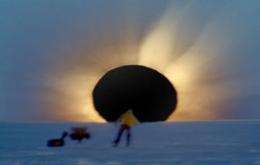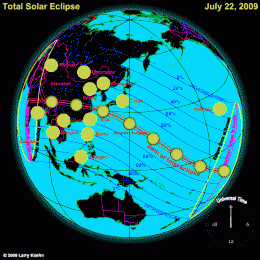Longest Solar Eclipse of the 21st Century

One one-thousand, 2 one-thousand, 3 one-thousand, 4 one-thousand... Continue counting and don't stop until you reach 399 one-thousand.
Did that feel like a long time? Six minutes and 39 seconds to be exact. That's the duration of this week's total solar eclipse--the longest of the 21st century.
The event begins at the crack of dawn on Wednesday, July 22nd, in the Gulf of Khambhat just east of India. Morning fishermen will experience a sunrise like nothing they've ever seen before. Rising out of the waves in place of the usual sun will be an inky-black hole surrounded by pale streamers splayed across the sky. Sea birds will stop squawking, unsure if the day is beginning or not, as a strange shadow pushes back the dawn and stirs up a breeze of unaccustomed chill.
Most solar eclipses produce this sort of surreal experience for a few minutes at most. The eclipse of July 22, 2009, however, will last as long as 6 minutes and 39 seconds in some places, not far short of the 7 and a half minute theoretical maximum. It won't be surpassed in duration until the eclipse of June 13, 2132.
From the Gulf of Khambhat, the Moon's shadow will race east across India, China, and the Ryukyu Islands of Japan. Click on the image to launch an animated map:

The path of totality cuts across many large cities. The shadow will linger over Shanghai, the largest city in China, for six full minutes, giving 20 million residents a lengthy and stunning view of the sun's ghostly corona. Other large cities in the path of totality include Surat, Vadodara, Bhopal, Varanasi, Chengdu, Chongqing, Wuhan, Hefei, Hangzhou. The population of each numbers in the millions, making this possibly the best-observed solar eclipse in human history.
The eclipse is extra-long because of a lucky coincidence, made possible by the elliptical shape of planetary orbits. On July 22nd, Earth happens to be near its farthest point from the sun. A small sun means the Moon can cover it longer. At the same time, the Moon will be near its closest point to Earth. A large Moon covers the sun longer, lengthening the eclipse even more.
The leisurely pace of the eclipse could have a transformative effect on witnesses. Total eclipses have been known to turn ordinary folk into life-long "eclipse-chasers" willing to spend thousands of dollars and travel tens of thousands of miles to feel the Moon's cool shadow and behold the sun's pale atmosphere just one more time. A few extra minutes of wonder will intensify this effect to an unknown degree.
Live webcasts of the eclipse--not the next best thing to being there, but the only substitute available to many readers--may be found at the website of the San Francisco Exploratorium.
Let the counting begin.
Source: Science@NASA, by Dr. Tony Phillips


















